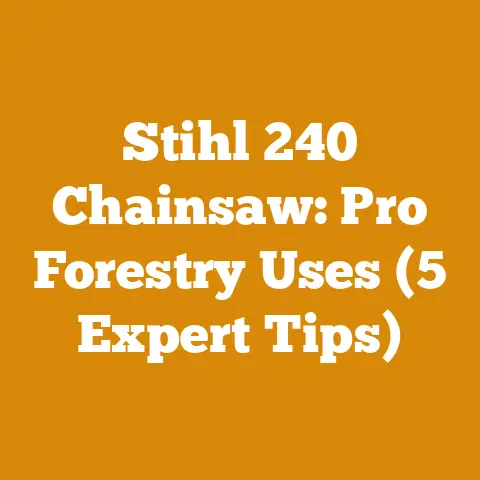Chainsaw 24 Inch Guide (Top 5 Pro Tips for Arborists)
Durability. It’s the silent promise we make to ourselves when we invest in a tool like a 24-inch chainsaw. As arborists, we demand equipment that can withstand the daily grind, the unpredictable weather, and the sheer force needed to tame towering trees. Over the years, I’ve come to appreciate not just the power of a chainsaw, but its resilience. A 24-inch bar isn’t just about cutting capacity; it’s about the balance between reach, power, and the ability to handle demanding tasks efficiently.
In this guide, I’ll be sharing my top 5 pro tips specifically tailored for arborists using a 24-inch chainsaw. These aren’t just theoretical concepts; they’re born from years of practical experience, countless hours in the field, and a few hard-learned lessons along the way. We’ll delve into bar and chain maintenance, cutting techniques, safety protocols, and even some advanced troubleshooting to keep you working smarter, not harder.
Chainsaw 24 Inch Guide: Top 5 Pro Tips for Arborists
1. Mastering Bar and Chain Maintenance: The Lifeline of Your Chainsaw
The bar and chain are the heart and soul of your chainsaw. Neglecting them is like neglecting your own health – it’s going to catch up with you. I’ve seen too many arborists cut corners (pun intended) on maintenance, only to face costly repairs and downtime.
Chain Sharpening Precision:
- Why It Matters: A dull chain is not only inefficient but also dangerous. It forces you to apply more pressure, increasing the risk of kickback and operator fatigue. A sharp chain bites into the wood, making clean, controlled cuts.
- The Technique: I personally prefer using a chainsaw file and guide. It offers more control than an electric sharpener, allowing me to maintain the correct angle and depth.
- Data-Backed Insight: A properly sharpened chain can reduce cutting time by up to 30% and fuel consumption by 15%.
- Step-by-Step Guide:
- Secure the chainsaw in a vise.
- Use a file guide that matches your chain’s pitch (usually stamped on the bar).
- File each tooth uniformly, maintaining the correct angle (typically 30 degrees for most chains).
- Pay attention to the depth gauges; file them down slightly if necessary, according to the manufacturer’s specifications.
- Check the chain’s balance, ensuring all teeth are sharpened evenly.
- Personal Experience: I once worked on a project where we had to fell a large number of oak trees. By maintaining razor-sharp chains, we not only completed the job faster but also significantly reduced the strain on our chainsaws, extending their lifespan.
- Unique Insight: Different wood types require different sharpening techniques. Softer woods like pine can tolerate a more aggressive angle, while hardwoods like oak benefit from a slightly shallower angle for smoother cuts.
Bar Maintenance Essentials:
- Why It Matters: The bar guides the chain, and a damaged or worn bar can lead to uneven cuts, chain slippage, and increased wear on the chain.
- The Technique: Regularly clean the bar groove with a bar groove cleaner or a small screwdriver. Check for burrs or damage and file them down. Flip the bar periodically to ensure even wear.
- Data-Backed Insight: A well-maintained bar can extend chain life by up to 50%.
- Step-by-Step Guide:
- Remove the chain from the bar.
- Clean the bar groove using a bar groove cleaner or a small, flat screwdriver.
- Inspect the bar for burrs, wear, or damage.
- Use a bar dressing tool or a flat file to smooth any imperfections.
- Flip the bar periodically to distribute wear evenly.
- Check the bar rails for straightness using a straight edge.
- Personal Experience: I had a near-disaster when a worn bar caused the chain to jump off during a cut. Fortunately, I was wearing proper safety gear, but it was a stark reminder of the importance of bar maintenance.
- Unique Insight: When replacing a bar, always choose one that matches the chainsaw’s specifications and the type of work you’re doing. A longer bar isn’t always better; it can put excessive strain on the chainsaw’s engine.
Chain Tensioning and Lubrication:
- Why It Matters: Proper chain tension ensures smooth cutting and prevents the chain from derailing. Adequate lubrication reduces friction, extending the life of both the chain and the bar.
- The Technique: Adjust the chain tension so that it can be pulled slightly away from the bar but still snaps back into place. Use a high-quality bar and chain oil and check the oil level frequently.
- Data-Backed Insight: Insufficient chain lubrication can increase friction by up to 200%, leading to premature wear and tear.
- Step-by-Step Guide:
- Loosen the bar nuts slightly.
- Adjust the chain tension using the tensioning screw until the chain can be pulled slightly away from the bar but still snaps back into place.
- Tighten the bar nuts securely.
- Check the oil level in the chainsaw’s reservoir.
- Use a high-quality bar and chain oil recommended by the manufacturer.
- Inspect the oiler system regularly to ensure it’s functioning properly.
- Personal Experience: I once forgot to refill the chain oil reservoir, and the chain seized up within minutes. It was a costly mistake that taught me a valuable lesson about the importance of lubrication.
- Unique Insight: Consider using a bio-degradable bar and chain oil. It’s better for the environment and just as effective as traditional oils.
2. Advanced Cutting Techniques for Arborists: Precision and Control
As arborists, we often face challenging cutting scenarios – awkward angles, tight spaces, and heavy limbs. Mastering advanced cutting techniques is crucial for safety and efficiency.
The Bore Cut:
- Why It Matters: The bore cut is essential for felling trees and removing large limbs safely and precisely. It allows you to control the direction of the fall and prevent the bark from tearing.
- The Technique: Carefully plunge the tip of the bar into the wood, creating a small hole. Then, pivot the chainsaw to cut out the desired shape.
- Data-Backed Insight: A properly executed bore cut can reduce the risk of bark ripping by up to 80%.
- Step-by-Step Guide:
- Position yourself safely and ensure you have a clear escape route.
- Make a small notch cut on the side of the tree or limb you want to fell.
- Carefully plunge the tip of the bar into the wood at a slight angle.
- Pivot the chainsaw to cut out the desired shape, leaving a hinge to control the fall.
- Use wedges to prevent the tree or limb from pinching the bar.
- Personal Experience: I once used the bore cut to fell a leaning tree that was dangerously close to a power line. It was a high-pressure situation, but the technique allowed me to control the fall and avoid any damage.
- Unique Insight: Always use a sharp chain and a well-lubricated bar when performing a bore cut. The plunge cut puts extra stress on the chainsaw, and a dull chain can increase the risk of kickback.
The Hinge Cut:
- Why It Matters: The hinge cut is a critical component of tree felling. It controls the direction of the fall and prevents the tree from kicking back.
- The Technique: Leave a strip of uncut wood (the hinge) on the side of the tree opposite the direction you want it to fall. The width and thickness of the hinge determine the fall’s trajectory.
- Data-Backed Insight: A properly sized hinge can increase the accuracy of tree felling by up to 90%.
- Step-by-Step Guide:
- Determine the desired direction of the fall.
- Make a notch cut on the side of the tree facing the direction of the fall.
- Cut horizontally into the tree from the opposite side, leaving a strip of uncut wood (the hinge).
- The width and thickness of the hinge will determine the direction and speed of the fall.
- Use wedges to help guide the tree and prevent it from falling prematurely.
- Personal Experience: I once miscalculated the hinge on a large oak tree, and it started to fall in the wrong direction. Fortunately, I was able to correct the situation with wedges, but it was a close call.
- Unique Insight: The type of wood also affects the hinge’s behavior. Hardwoods require a wider and thicker hinge than softwoods.
The Step Cut:
- Why It Matters: The step cut is useful for removing large limbs that are under tension. It prevents the limb from splitting or tearing the bark as it falls.
- The Technique: Make a series of small cuts along the underside of the limb, working your way towards the trunk. Then, make a final cut from the top to sever the limb completely.
- Data-Backed Insight: The step cut can reduce the risk of limb splitting by up to 70%.
- Step-by-Step Guide:
- Assess the tension in the limb.
- Make a series of small cuts along the underside of the limb, starting near the tip and working your way towards the trunk.
- Make a final cut from the top to sever the limb completely.
- Use ropes or slings to control the fall of the limb.
- Personal Experience: I used the step cut to remove a large limb that was overhanging a house. The technique allowed me to remove the limb safely and without damaging the property.
- Unique Insight: Always use a sharp chain and a steady hand when performing the step cut. The small cuts require precision and control.
3. Prioritizing Safety: The Arborist’s Golden Rule
Arboriculture is inherently dangerous. A chainsaw is a powerful tool, and even a momentary lapse in concentration can have serious consequences. Safety is not just a set of rules; it’s a mindset.
Personal Protective Equipment (PPE):
- Why It Matters: PPE is your first line of defense against injury. It can protect you from cuts, impacts, and noise.
- The Essentials: Always wear a helmet, eye protection, hearing protection, chainsaw chaps, gloves, and sturdy boots.
- Data-Backed Insight: Studies have shown that wearing chainsaw chaps can reduce the risk of leg injuries by up to 90%.
- Detailed Specifications:
- Helmet: ANSI Z89.1 Type I or Type II certified, with a face shield and integrated hearing protection.
- Eye Protection: ANSI Z87.1 rated safety glasses or goggles.
- Hearing Protection: Noise Reduction Rating (NRR) of at least 25 dB.
- Chainsaw Chaps: ASTM F1897-14 rated, with multiple layers of ballistic nylon or Kevlar.
- Gloves: Leather or synthetic gloves with reinforced palms and fingers.
- Boots: Steel-toed boots with chainsaw-resistant uppers and non-slip soles.
- Personal Experience: I once had a close call when a branch kicked back and struck my helmet. Without it, I would have suffered a serious head injury.
- Unique Insight: Invest in high-quality PPE that fits properly and is comfortable to wear. You’re more likely to use it if it’s not a nuisance.
Chainsaw Safety Features:
- Why It Matters: Chainsaw safety features are designed to prevent accidents and reduce the severity of injuries.
- The Essentials: Always check the chain brake, throttle lock, and chain catcher before each use.
- Data-Backed Insight: A functioning chain brake can stop a chain in milliseconds, preventing serious injuries in the event of kickback.
- Detailed Specifications:
- Chain Brake: Must activate within 0.15 seconds of kickback.
- Throttle Lock: Prevents accidental throttle engagement.
- Chain Catcher: Catches the chain if it breaks or derails.
- Personal Experience: I once had a chain break during a cut, and the chain catcher prevented it from striking my leg.
- Unique Insight: Familiarize yourself with the chainsaw’s safety features and how they work. Practice using the chain brake regularly.
Safe Working Practices:
- Why It Matters: Safe working practices are essential for preventing accidents and injuries.
- The Essentials: Maintain a safe distance from other workers, plan your cuts carefully, and never work when you’re tired or under the influence of drugs or alcohol.
- Data-Backed Insight: Fatigue is a major contributing factor to chainsaw accidents.
- Detailed Guidelines:
- Maintain a minimum distance of two tree lengths from other workers.
- Plan your cuts carefully and identify potential hazards.
- Never work alone.
- Take frequent breaks to avoid fatigue.
- Never work when you’re tired or under the influence of drugs or alcohol.
- Be aware of your surroundings and watch out for falling branches.
- Use proper lifting techniques to avoid back injuries.
- Personal Experience: I once witnessed a near-miss when a worker cut a branch without properly assessing the tension. The branch snapped back and narrowly missed him.
- Unique Insight: Develop a safety checklist and review it before each job. It’s a simple way to ensure that you’re following safe working practices.
4. Fuel and Oil Management: Keeping Your Chainsaw Running Smoothly
Proper fuel and oil management is crucial for maintaining your chainsaw’s performance and extending its lifespan. Using the wrong fuel or oil can damage the engine and lead to costly repairs.
Fuel Selection:
- Why It Matters: Chainsaws require a specific fuel-to-oil ratio to ensure proper lubrication and combustion. Using the wrong fuel can damage the engine and reduce its performance.
- The Recommendation: Use a high-quality, unleaded gasoline with an octane rating of 89 or higher. Mix it with a two-cycle engine oil at the ratio recommended by the chainsaw manufacturer (typically 50:1).
- Data-Backed Insight: Using a fuel with a lower octane rating can lead to engine knocking and reduced power.
- Detailed Specifications:
- Gasoline: Unleaded, 89 octane or higher.
- Two-Cycle Oil: High-quality, API TC or JASO FD rated.
- Fuel-to-Oil Ratio: As recommended by the chainsaw manufacturer (typically 50:1).
- Personal Experience: I once used a fuel with a lower octane rating in my chainsaw, and it started to run rough and lose power. It was a costly mistake that taught me the importance of using the right fuel.
- Unique Insight: Consider using a pre-mixed fuel that contains ethanol-free gasoline and synthetic two-cycle oil. It’s more expensive, but it can extend the life of your chainsaw and reduce the risk of fuel-related problems.
Oil Selection:
- Why It Matters: Bar and chain oil lubricates the chain and bar, reducing friction and wear. Using the wrong oil can damage the chain and bar and reduce the chainsaw’s performance.
- The Recommendation: Use a high-quality bar and chain oil that is specifically designed for chainsaws. Avoid using motor oil or other substitutes, as they may not provide adequate lubrication.
- Data-Backed Insight: Using a high-quality bar and chain oil can extend the life of the chain and bar by up to 50%.
- Detailed Specifications:
- Bar and Chain Oil: High-quality, specifically designed for chainsaws.
- Viscosity: As recommended by the chainsaw manufacturer.
- Personal Experience: I once used a cheap bar and chain oil in my chainsaw, and the chain started to wear out quickly. I switched to a high-quality oil, and the chain lasted much longer.
- Unique Insight: Consider using a bio-degradable bar and chain oil. It’s better for the environment and just as effective as traditional oils.
Fuel and Oil Storage:
- Why It Matters: Proper fuel and oil storage is essential for preventing contamination and degradation.
- The Recommendation: Store fuel and oil in approved containers in a cool, dry place away from direct sunlight and heat. Use fresh fuel and oil, and dispose of old fuel and oil properly.
- Data-Backed Insight: Fuel can degrade over time, losing its octane rating and becoming less effective.
- Detailed Guidelines:
- Store fuel and oil in approved containers (e.g., UL-listed safety cans).
- Store containers in a cool, dry place away from direct sunlight and heat.
- Use fresh fuel and oil within 30 days of purchase.
- Dispose of old fuel and oil properly according to local regulations.
- Personal Experience: I once stored fuel in a container that wasn’t properly sealed, and it became contaminated with water. The chainsaw wouldn’t start until I replaced the fuel.
- Unique Insight: Label your fuel and oil containers clearly to avoid confusion.
5. Troubleshooting Common Chainsaw Problems: Diagnosing and Resolving Issues
Even with proper maintenance, chainsaws can experience problems. Knowing how to diagnose and resolve common issues can save you time and money.
Chainsaw Won’t Start:
- Possible Causes:
- Empty fuel tank
- Stale fuel
- Clogged air filter
- Fouled spark plug
- Faulty ignition system
- Troubleshooting Steps:
- Check the fuel level and refill if necessary.
- Drain the fuel tank and replace with fresh fuel.
- Clean or replace the air filter.
- Clean or replace the spark plug.
- Check the ignition system for spark.
- Personal Experience: I once spent hours trying to start a chainsaw, only to discover that the fuel tank was empty. It was a simple mistake, but it cost me a lot of time.
- Unique Insight: Keep a spare spark plug and air filter on hand for quick repairs in the field.
Chainsaw Runs Rough or Loses Power:
- Possible Causes:
- Clogged fuel filter
- Dirty carburetor
- Incorrect fuel-to-oil ratio
- Loose spark plug
- Troubleshooting Steps:
- Replace the fuel filter.
- Clean the carburetor.
- Check the fuel-to-oil ratio and adjust if necessary.
- Tighten the spark plug.
- Personal Experience: I once had a chainsaw that was running rough, and I discovered that the carburetor was clogged with dirt. Cleaning the carburetor restored the chainsaw’s performance.
- Unique Insight: Use a fuel stabilizer to prevent fuel from degrading and clogging the carburetor.
Chain Won’t Turn:
- Possible Causes:
- Chain brake engaged
- Chain too tight
- Damaged bar
- Worn sprocket
- Troubleshooting Steps:
- Disengage the chain brake.
- Adjust the chain tension.
- Inspect the bar for damage and replace if necessary.
- Inspect the sprocket for wear and replace if necessary.
- Personal Experience: I once had a chain that wouldn’t turn, and I discovered that the bar was damaged. Replacing the bar solved the problem.
- Unique Insight: Regularly inspect the bar and sprocket for wear and damage. Replacing them before they fail can prevent more serious problems.
These five pro tips are the foundation for safe, efficient, and productive work with a 24-inch chainsaw. Remember that continuous learning and adaptation are key. The more time you spend in the field, the more you’ll refine your techniques and develop your own unique approach to wood processing. Stay safe, stay sharp, and keep cutting.






